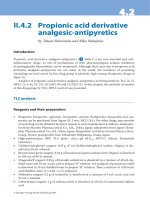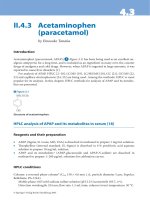Tài liệu Mayo Clinic Images in Internal Medicine: Self-Assessment for Board Exam Review docx
Bạn đang xem bản rút gọn của tài liệu. Xem và tải ngay bản đầy đủ của tài liệu tại đây (23.77 MB, 385 trang )
dramroo@yahoo.com
Self-Assessment for Board Exam Review
Mayo Clinic
Images in Internal Medicine
Front matter_FINAL.qxd 5/25/04 8:09 AM Page i
Front matter_FINAL.qxd 5/25/04 8:09 AM Page ii
Self-Assessment for Board Exam Review
Mayo Clinic
Images in Internal Medicine
Editor
Furman S. McDonald, MD
Co-Editors
Paul S. Mueller, MD
Gautam Ramakrishna, MD
MAYO CLINIC SCIENTIFIC PRESS
CRC PRESS
Front matter_FINAL.qxd 5/25/04 8:09 AM Page iii
ISBN-0-8493-3079-3
The triple-shield Mayo logo and the words MAYO and MAYO CLINIC are
marks of Mayo Foundation for Medical Education and Research.
©2004 Mayo Foundation for Medical Education and Research.
All rights reserved. This book is protected by copyright. No part of it may be
reproduced, stored in a retrieval system, or transmitted, in any form or by any
means—electronic, mechanical, photocopying, recording, or otherwise—without
the prior written consent of the copyright holder, except for brief quotations
embodied in critical articles and reviews. Inquiries should be addressed to
Mayo Clinic, 200 First Street SW, Rochester, MN 55905.
For order inquiries, contact CRC Press, 2000 NW Corporate Blvd., Boca Raton,
FL 33431.
www.crcpress.com
Care has been taken to confirm the accuracy of the information presented and
to describe generally accepted practices. However, the authors, editors, and
publisher are not responsible for errors or omissions or for any consequences
from application of the information in this book and make no warranty, express
or implied, with respect to the contents of the publication. This book should not
be relied on apart from the advice of a qualified health care provider.
The authors, editors, and publisher have exerted efforts to ensure that
drug selection and dosage set forth in this text are in accordance with current
recommendations and practice at the time of publication. However, in view of
ongoing research, changes in government regulations, and the constant flow of
information relating to drug therapy and drug reactions, the reader is urged to
check the package insert for each drug for any change in indications and dosage
and for added warnings and precautions. This is particularly important when
the recommended agent is a new or infrequently employed drug.
Some drugs and medical devices presented in this publication have Food
and Drug Administration (FDA) clearance for limited use in restricted research
settings. It is the responsibility of the health care providers to ascertain the
FDA status of each drug or device planned for use in their clinical practice.
Front matter_FINAL.qxd 5/25/04 8:09 AM Page iv
v
DEDICATED TO
Four very special people:
• Charles H. Rohren, MD—the best physical diagnostician I
know. A great physician, teacher, mentor, and friend. You
are the reason I am an internist today. I will always see you
when I think of the physician I want to be.
• Darryl S. Chutka, MD—a great physician and teacher. When
you told me to “make the book as large as you like,” I don’t
think you expected what would come of it. Without your
support and allowance for creative freedom, this book would
never have been written.
• Henry J. Schultz, MD—the greatest single influence on my
professional life. Program director, adviser, friend. I hope
that this book will be useful to the residents you care so
much about, of whom I know I am one.
• Elizabeth S. McDonald, MD, PhD—my devoted wife.
Thanks for putting up with me while I put so much time
into this book.
One very special program:
Proceeds from the book will support the Mayo International
Health Program, which defrays the cost of elective experiences
for Mayo Clinic residents and fellows caring for underserved
patients in international settings.
Furman S. McDonald, MD
Front matter_FINAL.qxd 5/25/04 8:09 AM Page v
Front matter_FINAL.qxd 5/25/04 8:09 AM Page vi
vii
PREFACE
Mayo Clinic Images in Internal Medicine: Self-Assessment for Board
Exam Review was begun in 1998 as an adjunct to a presentation
for the Mayo Internal Medicine Board Review Course. Images
were presented in random order with brief case scenarios. The
reader was encouraged to consider the cases before turning the
page to read a few learning points about each image. That first
book contained 38 cases and 57 images from 6 contributors.
Year by year the work was expanded until now the current
book has 173 cases with 287 images from 28 contributors. As
with the first book, all images are from patients seen at Mayo
Clinic, and the cases have been designed to illustrate important
teaching points. American Board of Internal Medicine–type
board review questions accompany the cases. The references
from which the content for each case scenario was built are
provided so the reader can obtain further information. Cases
are presented in random order to be a more effective review
tool that simulates examination (and clinical practice) condi-
tions. However, with the increase in size, a detailed index was
developed to allow the reader to find cases more efficiently. In
addition, this edition introduces chain referencing, an innova-
tive learning technique that allows the reader to move from
case to case based on specialty designation. With access to
the information in this book through random case review, the
detailed reference index, and specialty chain referencing, Mayo
Clinic Images in Internal Medicine: Self-Assessment for Board Exam
Review is really three effective learning texts bound in one cover.
It is hoped that Mayo Clinic Images in Internal Medicine:
Self-Assessment for Board Exam Review will be an aid for prepa-
ration for board examination certification or recertification
and medical clerkship review and also a useful update for
practicing clinicians.
Furman S. McDonald, MD
Editor
Front matter_FINAL.qxd 5/25/04 8:09 AM Page vii
ACKNOWLEDGMENTS
Many thanks are due to all who helped in the preparation of this
book. There are many, and I will not try to name them all.
This work was supported in part by the Clinical Educator and
Educational Initiative Program, an integral grant program of
Mayo Clinic. We are most appreciative of this support.
viii
Front matter_FINAL.qxd 5/25/04 8:09 AM Page viii
ix
AUTHOR AFFILIATIONS
Furman S. McDonald, MD
Senior Associate Consultant, Division of General Internal
Medicine–Hospital Medicine, Mayo Clinic
Associate Program Director, Internal Medicine Residency, Mayo
School of Graduate Medical Education, Mayo Clinic College of
Medicine
Assistant Professor of Medicine, Mayo Clinic College of Medicine
Rochester, Minnesota
Paul S. Mueller, MD
Consultant, Division of General Internal Medicine, Mayo Clinic
Assistant Professor of Medicine, Mayo Clinic College of Medicine
Rochester, Minnesota
Gautam Ramakrishna, MD
Fellow in Cardiovascular Diseases, Mayo School of Graduate
Medical Education, Mayo Clinic College of Medicine
Assistant Professor of Medicine, Mayo Clinic College of Medicine
Rochester, Minnesota
Image Contributors
Edith M. Andrist
Marc H. Bivins, MD
Emmanouil S. Brilakis, MD
B. Ryan Brady, MD
Darryl S. Chutka, MD
Mark D. P. Davis, MD
Laura A. Diamondopoulos, MD
David Dingli, MD
Jon O. Ebbert, MD
Stephen C. Hammill, MD
Melinda J. Johnson, MD
Patrick S. Kamath, MD
Thomas S. Lin, MD
James S. Mathur, MD
Elizabeth S. McDonald, MD, PhD
Furman S. McDonald, MD
David E. Midthun, MD
Victor M. Montori, MD
Carlos E. Morales, MD
John (Jack) D. Myers, MD
Roger L. Nelson, MD
Julian J. Nicholas, MD
Lynne E. Nowak, MD
David M. Phelan, MD
Jan Stepanek, MD
Craig S. Stump, MD
Wilber W. Su, MD
Farhad Zangeneh, MD
Front matter_FINAL.qxd 5/25/04 8:09 AM Page ix
Front matter_FINAL.qxd 5/25/04 8:09 AM Page x
xi
TABLE OF CONTENTS
Preface . . . . . . . . . . . . . . . . . . . . . . . . . . . . . . . . . . . . . . . . . . . vii
Abbreviations . . . . . . . . . . . . . . . . . . . . . . . . . . . . . . . . . . . . . xii
How to Use This Book . . . . . . . . . . . . . . . . . . . . . . . . . . . . . . xiii
Cases 1-173 . . . . . . . . . . . . . . . . . . . . . . . . . . . . . . . . . . . . . 1-348
Appendix: Cases by Specialty . . . . . . . . . . . . . . . . . . . . . . . 349
Index . . . . . . . . . . . . . . . . . . . . . . . . . . . . . . . . . . . . . . . . . . . . 353
Front matter_FINAL.qxd 5/25/04 8:09 AM Page xi
xii
ABBREVIATIONS
The chain references listed at the bottom of the content pages
use the following abbreviations for specialties:
Allergy/Immunol Allergy and Immunology
CAM Complementary and Alternative
Medicine
Crit Critical Care
CV Cardiovascular Diseases
Derm Dermatology
Endo Endocrinology
ENT Ear, Nose, and Throat
Genet Genetics
GI Gastroenterology
Hem Hematology
ID Infectious Diseases
Musc Musculoskeletal Diseases
Neph Nephrology
Neuro Neurology
Ob/Gyn Obstetrics and Gynecology
Oncol Oncology
Ophth Ophthalmology
Pulm Pulmonary Diseases
Rheum Rheumatology
Toxicol Toxicology
Vasc Vascular Diseases
Front matter_FINAL.qxd 5/25/04 8:09 AM Page xii
xiii
How to Use This Book
Most atlases of internal medicine and review texts group images
and content by specialty, an order that works well for reference
volumes. However, it does not resemble the random order of
cases in general clinical practice or on examinations. Further-
more, learning styles differ. The editors have endeavored to
make Mayo Clinic Images in Internal Medicine: Self-Assessment for
Board Exam Review useful for examination study, practice, and
reference, realizing that users of the book may have different
needs and different styles of learning. With this understanding,
we suggest the following ways to use this book:
1. Random case review: The order of the cases presented in
this book was determined with a random number generator;
thus, a case does not lend clues to the diagnosis or questions
related to the subsequent case. This most closely simulates
a general practice or examination setting. People who used
the prototypes of this book found this order useful for exam-
ination review.
2. Specialty-specific review with use of chain references:
Some readers may want to review cases in a single special-
ty. The bottom of the content page for each case includes
abbreviations for the specialty classifications of the case
followed by a page number directing the reader to the next
case of that specialty. After the last case in any specialty, the
page numbers refer to the first case in the series. Thus, the
reader can open the book at any page and review specifically
the cases of any specialty by following the chain references.
3. Cases by specialty: To find all the cases of any specialty,
a list of cases categorized by specialty and page number
is provided in the Appendix. Because some cases can be
classified with more than one specialty, these lists may
overlap.
4. Reference by index: For readers who want to find a par-
ticular image or content related to a particular subject, an
extensive index is provided.
Front matter_FINAL.qxd 5/25/04 8:09 AM Page xiii
A 37-year-old man received a bone marrow transplant 2 weeks
previously for acute myelogenous leukemia. Two days ago,
itching, diarrhea, pain and numbness in his palms and soles,
and the skin lesions shown here developed. Each of the follow-
ing statements about this condition is true except:
a. Use of HLA-identical grafts eliminates the risk of this con-
dition
b. This condition typically occurs 7 to 21 days after transplan-
tation
c. Increased age is a risk factor for this condition
d. Sex mismatch (female donor, male recipient) is a risk factor
for this condition
e. Values on liver function tests are often increased in this con-
dition
Case 1
1
Cases 1_10_FINAL.qxd 5/19/04 9:05 AM Page 1
Answer: a
• Occurs 7 to 21 days after transplantation
• Donor T cells attack host HLA antigens
• Mean frequency in adults with HLA-identical grafts is 35%
• Risk factors include the following:
Increased age
HLA mismatch
Sex mismatch (female donor, male recipient)
Irradiation
Suboptimal immunosuppression
•Affects the skin, gastrointestinal tract, and liver
•Pruritus and pain may be the first sensations, commonly
followed by an erythematous measles-like maculopapular
exanthem. Acral erythematous lesions may develop on
palms, soles, and ears
• Blistering and exfoliation are common
• Digestive tract involvement may present (from less severe to
more) as nausea, vomiting, anorexia, diarrhea, malabsorption,
abdominal pain, ileus, and ascites
•Values on liver function tests are often increased; jaundice
and hepatomegaly may develop
•Treatment involves intensifying immunosuppression, such
as high-dose corticosteroids, cyclosporine, and cyclophos-
phamide
• Severe cases (grade IV) have a high mortality rate (>80%)
Acute Graft-Versus-Host Disease
2
Next cases: Hem p. 19, Allergy/Immunol p. 57
References
Aractingi S, Chosidow O. Cutaneous graft-versus-host disease. Arch Dermatol.
1998;134:602-612.
Habermann TM. Mayo Clinic Internal Medicine Board Review 2004-2005.
Philadelphia: Lippincott Williams & Wilkins; 2004:182.
Cases 1_10_FINAL.qxd 5/19/04 9:05 AM Page 2
An 82-year-old man presents with 8 weeks of periorbital edema,
6 weeks of rash, and 2 weeks of bilateral shoulder and arm aches
and weakness. What is the diagnosis?
a. Polymyalgia rheumatica
b. Inclusion body myositis
c. Hypothyroidism
d. Polymyositis
e. Dermatomyositis
Case 2
3
Cases 1_10_FINAL.qxd 5/19/04 9:05 AM Page 3
Answer: e
• Three causes of idiopathic inflammatory myopathy:
Dermatomyositis (DM)
Polymyositis
Inclusion body myositis
• Dermatomyositis has a bimodal age distribution
• Skin findings associated with DM:
Heliotrope hue of the eyelids
Rash of the metacarpophalangeal and proximal inter-
phalangeal joints (Gottron’s papules)
Photosensitivity dermatitis of the face
•Proximal myositis with associated pain and weakness is
characteristic of DM
• The serum creatine kinase and aldolase values are usually
increased in DM
• The anti-Jo1 antibody is present in 25% of patients with DM
• The electromyogram is characteristic, but not diagnostic, of
the inflammatory myopathies
•Amuscle biopsy is suggested for all patients with inflamma-
tory myopathy
• Patients with DM have an increased risk for cancer
• DM is treated with immunosuppressive drugs
Dermatomyositis
4
Next Rheum case, p. 13
Reference
Habermann TM. Mayo Clinic Internal Medicine Board Review 2004-2005.
Philadelphia: Lippincott Williams & Wilkins; 2004:177, 789, 997-998.
Cases 1_10_FINAL.qxd 5/19/04 9:05 AM Page 4
The lesions in this patient developed 2 weeks after hiking in
the woods of the Upper Midwest in April. If left untreated, this
patient is at risk for development of all of the following except:
a. Fever, lymphadenopathy, meningismus
b. Carditis
c. Ischemic bowel
d. Cranial nerve palsies
e. Arthritis
Case 3
5
Cases 1_10_FINAL.qxd 5/19/04 9:05 AM Page 5
Answer: c
• Causative agent, Borrelia burgdorferi, is transmitted by Ixodes
ticks
• Highest incidence is during spring and summer
•Tick must be attached more than 24 hours for transmission
to occur
•Stage 1: Within 30 days of infection, erythema chronicum
migrans occurs in 80% of patients and may be associated
with fever, lymphadenopathy, and meningismus. The rash
resolves within 4 weeks
• Stage 2: Onset is weeks to months after stage 1. Neurologic
abnormalities occur in 10% to 15% of patients. Carditis occurs
in 10% of patients
• Stage 3: Begins months to years after infection. Arthritis
occurs in 50% of untreated patients, becoming chronic in
10% to 20%
•Enzyme-linked immunosorbent assay is positive for diag-
nosis within 2 to 6 weeks
• Early-stage disease may be treated with doxycycline, amox-
icillin, or cefuroxime
• Neurologic or cardiac involvement requires high-dose cef-
triaxone or penicillin G
Lyme Disease
6
Next ID case, p. 9
Reference
Habermann TM. Mayo Clinic Internal Medicine Board Review 2004-2005.
Philadelphia: Lippincott Williams & Wilkins; 2004:59, 180, 564-565, 755, 1000-
1001.
Cases 1_10_FINAL.qxd 5/19/04 9:05 AM Page 6
These are the hand and skin findings of a 26-year-old woman
who complains of early satiety. Her past medical history is
notable for upper gastrointestinal bleeding and rectal prolapse.
What is the diagnosis?
a. Ehlers-Danlos syndrome
b. Cutis laxa
c. Osteogenesis imperfecta
d. Congenital contractural arachnodactyly
e. Marfan syndrome
Case 4
7
Cases 1_10_FINAL.qxd 5/19/04 9:05 AM Page 7
Answer: a
• Ehlers-Danlos syndrome is characterized by highly elastic
connective tissue
• Many forms (up to 15) of Ehlers-Danlos syndrome exist
• The autosomal-dominant forms of the disease account for
90% of reported cases
•Patients have hyperextensible and lax joints that are prone
to dislocation
• Patients with skin manifestations have hyperextensible, fragile
skin that heals poorly, characteristically forming wide, thin,
“fish-mouth” scars. The skin may have a velvety texture
• Patients are predisposed to the following:
Gastrointestinal motility disorders
Visceral diverticulosis
Mitral valve prolapse (up to 50% of patients)
Dilatation of the aortic root
Pes planus
Scoliosis
Degenerative arthritis
Pneumothorax
Dilatation of the pulmonary artery
Angina
Ehlers-Danlos Syndrome
8
Next cases: Genet p. 29, Musc p. 61
Reference
Habermann TM. Mayo Clinic Internal Medicine Board Review 2004-2005.
Philadelphia: Lippincott Williams & Wilkins; 2004:178, 365.
Cases 1_10_FINAL.qxd 5/19/04 9:05 AM Page 8
Clinical criteria for toxic shock syndrome include all of the
following except:
a. Fever
b. Positive blood cultures
c. Hypotension
d. Involvement of 3 or more organ systems
e. Erythroderma
Case 5
9
Cases 1_10_FINAL.qxd 5/19/04 9:05 AM Page 9
Answer: b
• Acute life-threatening illness caused by production of
staphylococcal exotoxin (toxic shock syndrome toxin-1,
TSST-1)
• Centers for Disease Control and Prevention criteria:
6 required for confirmation; 5 of 6 indicate a probable case
1. Fever Temperature of more than 38.9°C
2. Rash Diffuse, macular, and erythematous
3. Desquamation Especially of palms and soles
4. Hypotension In adults, systolic blood pressure
less than 90 mm Hg
5. Multisystem Severe myalgias
involvement Diarrhea, vomiting
Liver dysfunction
Thrombocytopenia
Renal insufficiency
Mental status changes
6. Exclusion of other Negative results of blood, throat,
causes cerebrospinal fluid cultures
(usually not positive for
Staphylococcus aureus)
• Associations: menstruation with prolonged use of tampons,
surgery (even if wound is not worrisome), barrier contracep-
tives
•With early and aggressive management and judicious use of
antibiotics and supportive care, the mortality rate for toxic
shock syndrome has been estimated at 3%. The use of
corticosteroids (to lessen the overwhelming inflammatory
response) and immunoglobulins remains controversial
Toxic Shock Syndrome
10
Next ID case, p. 11
References
Habermann TM. Mayo Clinic Internal Medicine Board Review 2004-2005.
Philadelphia: Lippincott Williams & Wilkins; 2004:601-602.
Walker LE, Breiner MJ, Goodman CM. Toxic shock syndrome after explantation
of breast implants: a case report and review of the literature. Plast Reconstr
Surg. 1997;99:875-879.
Cases 1_10_FINAL.qxd 5/19/04 9:05 AM Page 10
A 37-year-old man with acquired immunodeficiency syndrome
(AIDS) presents with fever, seizures, and altered mental status.
His last known CD4 cell count was less than 50 cells/mm
3
.
Which one of the following is the best prophylactic agent for
this condition?
a. Rifabutin
b. Trimethoprim-sulfamethoxazole
c. Pyrimethamine
d. Fluconazole
e. Acyclovir
Case 6
11
Cases 1_10_FINAL.qxd 5/19/04 9:05 AM Page 11









